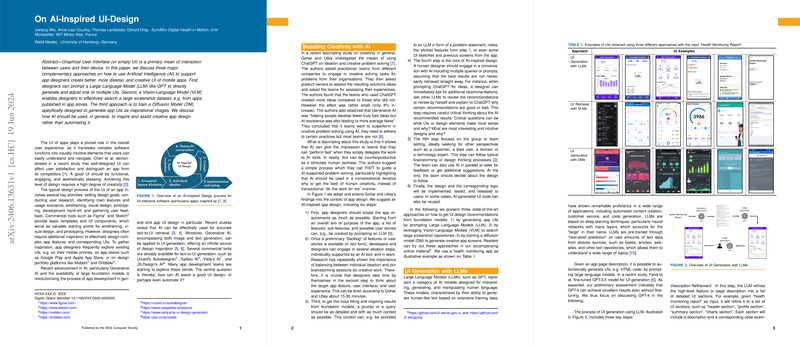The paper "On AI-Inspired UI-Design" by Jialiang Wei et al. provides a comprehensive exploration of how AI can enhance the design of mobile application User Interfaces (UIs). The research focuses on three primary AI strategies that can aid app designers in creating more creative, functional, and diverse UI designs. These strategies are centered around the use of LLMs, Vision-LLMs (VLMs), and Diffusion Models (DMs).
Key AI Approaches in UI Design:
- Prompting LLMs: The paper discusses how designers can leverage models like GPT to create entire UIs or modify existing layouts. LLMs are highlighted for their ability to generate human-like text, which can be used to transform textual descriptions of apps into structured HTML code. This process provides designers with a flexible tool for generating UI designs and refining them based on specific needs.
- Employing VLMs: Vision-LLMs are utilized for searching through large databases of UI screenshots, such as those found in app repositories. These models facilitate the association between textual queries and relevant images, making it easier to retrieve inspirational UI designs. VLMs are particularly useful in tapping into existing resources to inform new design projects.
- Training DMs: Diffusion Models are applied to generate UI images from textual prompts or page descriptions. These models are valued for their ability to produce a wide variety of UI designs, offering a rich source of design inspiration. However, the image-based nature of DMs can lead to graphical errors and challenges with the reusability of designs.
Evaluation and Challenges:
The paper provides a critical analysis of each AI approach, acknowledging both their strengths and limitations. LLMs offer a high degree of flexibility and ease in generating code, but they can struggle with the aesthetic quality and completeness of UI designs. VLMs deliver high-quality designs from existing apps but are restricted by the diversity of their dataset. DMs are praised for generating diverse and novel UIs, yet they often encounter issues related to graphical errors and reusability.
The authors also highlight practical considerations such as hardware requirements for executing LLMs locally, privacy concerns associated with cloud-based models, and the need for model fine-tuning for specific UI design tasks. These factors are noted as critical areas for future research and development.
Implications and Future Directions:
The paper underscores the potential significant impact of integrating AI into UI design processes, as it promises improvements in creativity and efficiency while maintaining the invaluable human aspect of design ideation and evaluation. The paper stresses the importance of balancing AI capabilities with designer expertise to maximize the effectiveness of these technologies in enhancing design outcomes.
Future research directions suggested by the authors include further integration of AI approaches to optimize UI design workflows, accommodating various team structures, and addressing domain-specific challenges. They also emphasize the need for thorough examination of AI-generated UI components to ensure they meet real-world technical and creative standards.
Conclusion:
Overall, this paper provides a nuanced look at how AI can be employed in UI design, positioning AI as a collaborative tool that enhances human creativity and supports diverse design results. By exploring the capabilities of LLMs, VLMs, and DMs, it sets a foundation for future innovations in app development and UI design, advocating for a synergistic approach that combines human intuition with AI technology.
